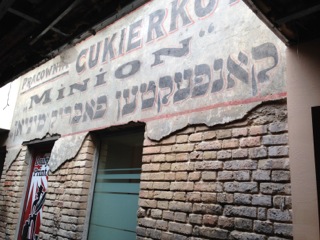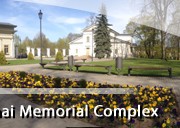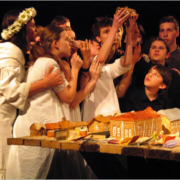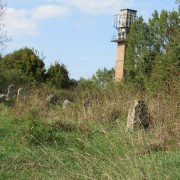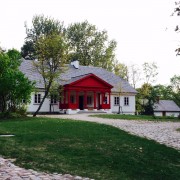Moving Away from Indifference: The Hidden Past of Vilnius, Lithuania
By Kelsey Klimara
After traveling for 20 days and to seven different cities, my favorite place is still the first. Vilnius, Lithuania has been the most impactful and memorable city thus far due to the history that is embedded within the city walls and due to the past that has been suppressed and forcibly forgotten.
I came into the semester knowing that I would be studying heavy topics such as the Holocaust and WWII, however, I did not expect to jump right in on the first day. I thought that we might take a little while to become acclimated to the city, but our first tour was not what I expected. In reality, our walking tour through Vilnius showed us a side of the city that was not obvious to outsiders. It was completely centered on exploring the major sites of the Jewish Ghetto in the city.
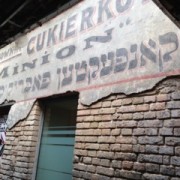 All of the sites we visited throughout the tour held evidence of the horrible conditions placed upon people in the ghetto during the war. First, we saw an old sign left over from a sweet shop containing Yiddish writing, which demonstrated the extent of the Jewish population of the time. Later, we saw the Choral Synagogue and an old Library that was located in the center of the ghetto in order to make the living conditions seem more normal. Originally we just stood outside of the non-descript building without even giving it a second glance. Then, the significance and power of the landscape dawned on me as our tour guide told us that it was the library placed in the center of the ghetto in order to create the illusion of “normality.” The conditions inflicted upon the Jews were anything but normal or humane. Yet, they were also forced to accept these atrocities as their reality. In a way, something as common as a public library may have made the living conditions slightly more bearable. The most incredible part of the tour was that if you walked through the area with no former knowledge, you would never know the atrocities that occurred there. There is almost no memorialization in Vilnius.
All of the sites we visited throughout the tour held evidence of the horrible conditions placed upon people in the ghetto during the war. First, we saw an old sign left over from a sweet shop containing Yiddish writing, which demonstrated the extent of the Jewish population of the time. Later, we saw the Choral Synagogue and an old Library that was located in the center of the ghetto in order to make the living conditions seem more normal. Originally we just stood outside of the non-descript building without even giving it a second glance. Then, the significance and power of the landscape dawned on me as our tour guide told us that it was the library placed in the center of the ghetto in order to create the illusion of “normality.” The conditions inflicted upon the Jews were anything but normal or humane. Yet, they were also forced to accept these atrocities as their reality. In a way, something as common as a public library may have made the living conditions slightly more bearable. The most incredible part of the tour was that if you walked through the area with no former knowledge, you would never know the atrocities that occurred there. There is almost no memorialization in Vilnius.
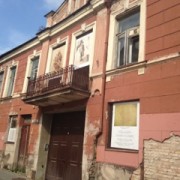 The next day, our group arrived at the sole Holocaust Museum in Lithuania. We were guided through the exhibit and were able to see, first-hand, various documents that show proof of the massacres. Once we finished up the tour, we were fortunate enough to have a sit-down discussion with one of the founders of the museum, Rachel Kostanian-Danzig. She spoke to our class about not learning directly from a book, but instead forming our own decisions about the cruel world we live in. If we accept everything that is given to us in a textbook and that has been put through a filter, we will be in danger of repeating the past. Kostanian-Danzig, a holocaust survivor herself, wants us all to actively seek out knowledge and history. I will never forget the moment when she looked at us with passion in her eyes and said, “Do not be indifferent.”
The next day, our group arrived at the sole Holocaust Museum in Lithuania. We were guided through the exhibit and were able to see, first-hand, various documents that show proof of the massacres. Once we finished up the tour, we were fortunate enough to have a sit-down discussion with one of the founders of the museum, Rachel Kostanian-Danzig. She spoke to our class about not learning directly from a book, but instead forming our own decisions about the cruel world we live in. If we accept everything that is given to us in a textbook and that has been put through a filter, we will be in danger of repeating the past. Kostanian-Danzig, a holocaust survivor herself, wants us all to actively seek out knowledge and history. I will never forget the moment when she looked at us with passion in her eyes and said, “Do not be indifferent.”
The day that has stuck with me and, in a way, haunted me the most is still my last day in Lithuania. That was the day that we visited the Museum to Genocide Victims and the Paneriai Memorial Museum.
The Museum to Genocide Victims is located in the former headquarters of the KGB. Once used by the Nazis and twice by the Soviets during their occupations, the extent of horrific actions and inhumane crises committed there, in a single building, are truly unfathomable. Most museum tours have never felt real to me for the simple fact that I was not alive during the time that the events actually occurred. This was completely different. I saw chambers specifically used for torture. I saw a room designated and designed for murder. I saw things I could not imagine that another human being could have created. Walking through the Soviet Secret Police headquarters was unlike anything I have ever done.
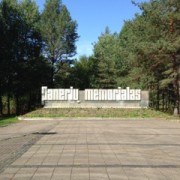 Our final stop in Lithuania was the Paneriai Memorial Museum. Our bus led us far back into a forest and for a while, all we could see was grass and trees. What we soon found out was that this forest is the site of seven mass graves used for mass executions during WWII. I was able to stand at the edge of the hole, see the vast opening and just imagine what went on at each gravesite. I was in a trance and could barely hear the tour guide’s words over my thoughts. I kept thinking: here I am, walking on the same path that someone trudged upon fully knowing that they were walking to their death. Both fascinating and heartbreaking, I will never forget that day.
Our final stop in Lithuania was the Paneriai Memorial Museum. Our bus led us far back into a forest and for a while, all we could see was grass and trees. What we soon found out was that this forest is the site of seven mass graves used for mass executions during WWII. I was able to stand at the edge of the hole, see the vast opening and just imagine what went on at each gravesite. I was in a trance and could barely hear the tour guide’s words over my thoughts. I kept thinking: here I am, walking on the same path that someone trudged upon fully knowing that they were walking to their death. Both fascinating and heartbreaking, I will never forget that day.
What was the most striking to me was that a few months ago I had never even heard of Vilnius. Now I come to find that it is one of the most beautiful, friendly, tragic, and historically relevant cities that I have ever studied. There is an incredible amount of history embedded and hidden within these city walls. Vilnius was once called the Jerusalem of the North and according to Timothy Snyder, once was home to 70,000 Jews. Why has the history of this city been almost completely forgotten? And how many other cities are out there that are missing from our grade school textbooks? The shockingly barbaric actions of both the Nazis and Soviets in Lithuania should not go unrecognized. Hopefully, throughout this semester I will discover what makes communities actively suppress their own history instead of facing it and moving forward.

